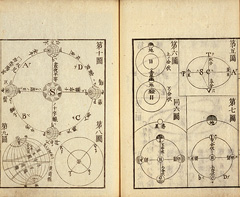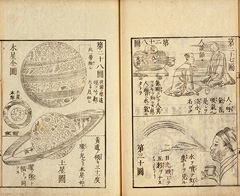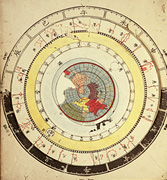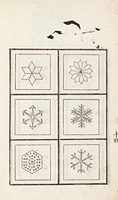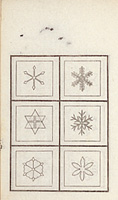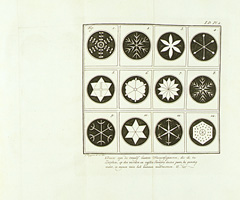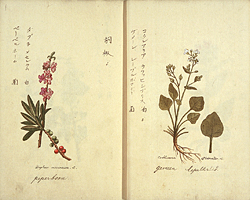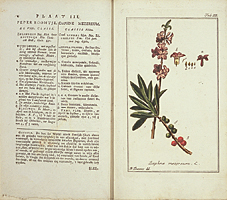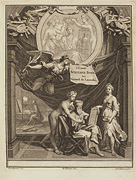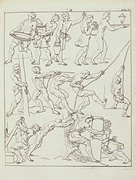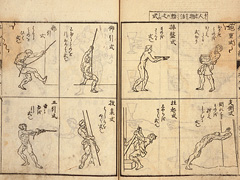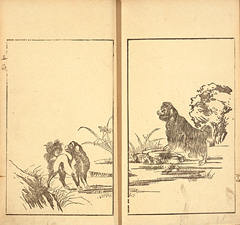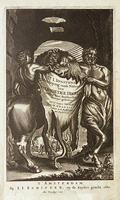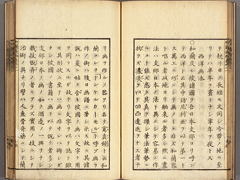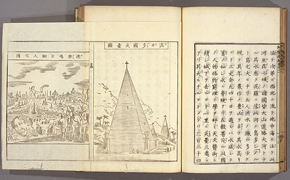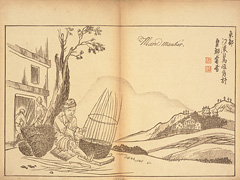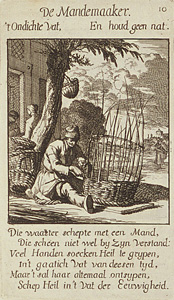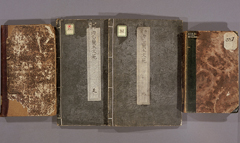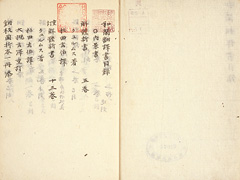The author, Iwahashi Yoshitaka (Zenbei, 1756-1811), was a telescope manufacturer. Heitengi (a kind of astrolabe) is a quick-reference chart for the paths of the sun, moon, and stars, and is used by turning the disc. The European continent area in the northern hemisphere on the top layer shows the location of the Netherlands in red. The title slip design was probably influenced by the title slip of Shiba Kokan's Chikyu zenzu. Belonged to the astronomer Watanabe Toshio.
Part 2: View by Topics 4. Receiving Knowledge from Overseas (1) Learning about Foreign Countries (2)
Home | Part 2: View by Topics | 4. Receiving Knowledge from Overseas (1) Learning about Foreign Countries (2)
Part 2: View by Topics
4. Receiving Knowledge from Overseas
(1) Learning about Foreign Countries (2)
Astronomy, Meteorology, Botany
The study of Western knowledge was focused on medicine and the natural sciences. Here we see the influence of Western knowledge on astronomy, meteorology and botany.
Kopperu tenmon zukai.
Tr. by Shiba Kokan. Toto: Shunparo, 1808. 1 v. <101-184>
Shiba Kokan was also interested in astronomy and introduced the heliocentric theory of Nicolaus Copernicus (1473-1543). The Copernican theory was first introduced to Japan by Motoki Ryoei, but Motoki's Tenchi nikyu yoho and similar works were not published and were only circulated as transcriptions.
Sekka zusetsu.
By Doi Toshitsura. S.l.: s.n., 1832. 1 v. <特1-2982>
Martinet, J. F.: Katechismus der natuur.
Amsterdam: W. Loveringh en Allart, 1778-79. 4 v. <WB29-34>
The author, Doi Toshitsura (1789-1848), was the lord of the Koga Domain in Shimousa Province. He also held important posts with the Shogunate government, such as serving as the Roju (senior councilor) during the Tenpo Reforms, but he also continued his observations of snow crystals from his teen years and produced two volumes of Sekka zusetsu (v. 2 was published in 1840) of crystal illustrations. This book includes 86 types of observation illustrations of Toshitsura and 12 types of reference illustrations from Katechismus der Natuur (called Kakuchi mondo in Japanese) written by Joannes Florentius Martinet (1729-1795), a Dutch priest. Kakuchi mondo (Questions and answers about nature) is an illuminative introduction to physical science. The Lord Doi privately published Sekka zusetsu, but the illustrations of the crystals were referenced for Hokuetsu seppu (1836) written by Suzuki Bokushi, and thus were widely circulated and became popular snow crystal patterns.
Column: The Age of Sekka zusetsu
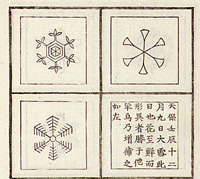
Doi Toshitsura, the author of Sekka zusetsu, put down the Oshio Heihachiro Rebellion in 1837 while serving as the Guardian of Osaka Castle, but one of the causes of the rebellion was the famine caused by extremely cold weather. The poor weather and famine from 1833, which is called the Tenpo Famine, coincidentally occurred at the same time as Toshitsura was making his snow crystal observations. This shows his entry that, "On January 29, 1833, there was a heavy snow and the snow crystals could be very distinctly seen and some exhibited shapes not seen in other years." Snowflakes melt very easily and cannot be observed well unless the temperature is -5oC or colder, but that fact that the snowflakes could be easily observed in Koga and Osaka, which are not known as frigid regions, is evidence of how cold it was at the time.
Oranda roppyaku yakuhin zu.
Ms. 7 v. in 4. <せ-19>
Oskamp, D. L.: Afbeeldingen der artseny-gewassen met derzelver nederduitsche en latynsche beschryvingen.
Amsterdam: J. C. Sepp en Zoon, 1796-1800. 6 v. <WB29-35>
Afbeeldingen der artseny-gewassen met derzelver nederduitsche en latynsche beschryvingen (called Yakuyo shokubutsu zufu in Japanese) edited by Dieterich Leonard Oskamp et al., was imported during the Tenpo period (1830-1843) and used by herbalists. Oranda roppyaku yakuhin zu is a copy of just the illustrations from this book. The Latin name, Dutch name, Chinese name, and Japanese name for each medicinal herb were given. While some of the illustrations have been left out, most of them were carefully copied in great detail. A note written in the end of the Oranda roppyaku yakuhin zu suggests that it was the herbalist Yamamoto Sekifu (1809-1864) who wrote in the Chinese and Japanese names. The illustrations in Afbeeldingen der artseny-gewassen ... are hand-colored copperplate etchings.
![]() Go here for information on the effect that the Western books on flora and fauna had on Japanese herbalists.
Go here for information on the effect that the Western books on flora and fauna had on Japanese herbalists.
Comparison between Oranda roppyaku yakuhin zu. and Yakuyo shokubutsu zufu
Paintings
Tokugawa Yoshimune showed interest in Western illustrated fauna and flora books, and Sugita Genpaku and others were so surprised at the realism of the illustrations in Western medical books that they published Kaitai shinsho (Overview). Indeed, Dutch studies scholars gained much information helped by the Western illustrations. There were also artists who studied Western pictures and were influenced by them.
Lairesse, G. de: Groot schilderboek.
Haarlem : J. Marschoorn, 1740. 2 v. <WB29-30>
This book was called Dai gahosho, Dai kaigahon, or some other variation in Japanese. This book was authored by Dutch painter Gerard de Lairesse (1640-1711). It covers all the drawing techniques including mythological pictures, historic pictures, sketching, use of light and shadow, perspective, chromatics, and copperplate prints and even adds commentary. It was also used as a reference for the illustrations of people in Morishima Churyo's Komo zatsuwa and was even copied by Aodo Denzen (2-2 Ihan teiko zu), but that does not necessarily mean the contents of the book were understood well.
Kokon gaso.
Edited by So Shiseki. S.l.: s.n., 1770-71. 8 v. in 4. <181-192>
Jonston, J.: Naeukeurige beschryving van de natuur der vier-voetige dieren, vissen en bloedlooze water-dieren, vogelen, kronkel-dieren, slangen en draken.
Amsterdam: I. I. Schipper, 1660. 1 v. <WB29-12>
So Shiseki (1715-1786) in Nagasaki learned the drawing style of Shen Nanpin School, which was excellent for realistic expression. Shiba Kokan was his pupil. He also associated with Hiraga Gennai and was in charge of the illustrations used in Butsurui hinshitsu. Shiseki's illustrations in this Kokon gaso are animals pictures in the 'Ihin' (foreign goods) section for which J. Jonston's Naeukeurige 'beschryving van de natuur der viervoetige dieren were referenced. The falling of animal shadows on the ground was ignored. Naeukeurige beschryving van de natuur der viervoetige dieren was used as a reference by many artists including Akita Satake Domain samurai Odano Naotake (1749-1780) who illustrated Kaitai shinsho. Belonged to Nagoya book lender Onoya Sohachi (Daiso).
Oranda tsuhaku.
Edited by Shiba Kokan. Toto: Shunparo, 1805. 2 v. in 1. <124-233>
In 1799, Shiba Kokan published Seiyo gadan, which describes Western art appreciation. Although this book is a geography, he also added the subjects 'Western drawing' and 'Copperplate illustrations' to it. He also discusses J. Jonston's Naeukeurige beschryving van de natuur der viervoetige dieren. The first Japanese books on Western art technique were Gaho koryo and Gazu rikai written by the Akita Domain Lord Satake Yoshiatsu (Shozan, 1748- 1785), but both of these were manuscripts, whereas in Seiyo gadan and this book Kokan published Western art theory, which is very significant. The illustrations in this book were printed on separate paper as were the plates in Western books and then were inserted into the appointed pages.
Keisei gaen.
Edited by To Shigetaka. Heian: Yoshida Shinbei, 1814. 1 v. (accordion fold) <189-1>
Luiken, J.; Luiken C. : Het menselyk bedryf.
t'Amsterdam: J. en Caspaares Luiken, 1694. 1 v. <WB29-28>
This picture is drawn by Shiba Kokan and he used Het menselyk bedryf by Jan Luiken (1649-1712) as a reference. Luiken's book is a collection of copperplate prints containing drawings of people in over 100 trades. Keisei gaen is a collection of 24 multi-colored woodcut prints by Kyoto artists. Kokan was residing in Kyoto in 1812.
Publishing
The knowledge brought from the Netherlands produced a variety of books including translations, research works, and educational books. This section introduces the impact of the Netherlands seen in Japanese publishing.
Weiland, P.: Nederduitsche spraakkunst.
Nieuwe door den auteur zelven overziene en verb. druk. Dordrecht: B. en van Braam, 1846. 1 v. <蘭-112>
Oranda Weirando bunten. Shohen.
By P. Weiland. Edo: Yamashiroya Sahei, etc., 1856 reprinted. 2 v. <蘭-3366> <蘭-960>
Weiland, P.: Nederduitsche spraakkunst.
[Nagasaki, 1859] <蘭-646>
Nederduitsche Spraakkunst by Dutch linguist Pieter Weiland (1754-1842) was heavily used by Dutch studies scholars and was in high demand. <蘭-112> is the original book published in the Netherlands; <蘭-3366> and <蘭-960> are reprints using wood-cut printings done in Edo. The original was printed with a Roman type , but this book uses handwriting letter, because using handwriting makes it easier to create the wood block. <蘭-646> was printed in Nagasaki using metal type. At first glance it looks like the original, but there are many places showing deficient printing skills such as composition mistakes like "Inleidig" instead of "Inleiding." <蘭-112> and <蘭-646> were belonged to the Bureau for the Inspection of Barbarian Books and <蘭-3366> and <蘭-960> were belonged to Bingo Fukuyama Domain school Seisikan, which was enthusiastic about Western education.
Oranda honyakusho mokuroku.
Ms. 1 v. <わ027-1>
This is a sales catalog of books translated from Dutch and Dutch studies books by Kyoto bookseller Yoshida Jihei in 1841. Approximately 100 books including Kaitai shinsho and Yakken are listed. At the end it says, "These books listed are all in stock or can be copied, so feel free to place an order," showing that the dealer had all of the books in inventory or could reproduce them and was soliciting orders. This is a significant material showing the state of distribution of books during the Edo period.
Seiyo gakka yakujutsu mokuroku.
Edited by Suitei Shujin. S.l.: s.n., 1854? 1 v. <198-347>
This is a catalog of 125 Western studies scholars from around 1744-47 by Suitei Shujin (dates of birth and death unknown). It includes their surnames in Japanese syllabary order, as well as their pen names, place of origin, and their works. This widely includes mainly medical books but also transcribed books on botany, astronomy, and geography.
Copyright © 2009 National Diet Library. Japan. All Rights Reserved

